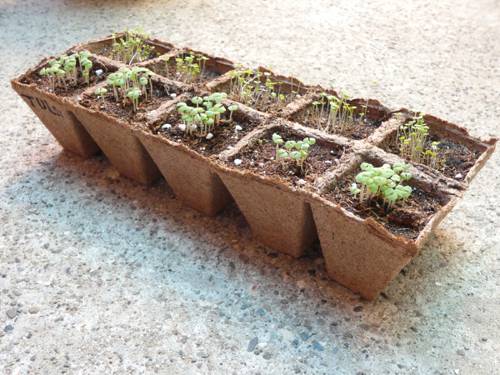
FAQ About Indoor Plant Biodegradable Potting Options

What are biodegradable potting options for indoor plants?
Biodegradable potting options for indoor plants include pots made from materials like coconut coir, rice hulls, peat, and plant fibers. These materials break down naturally over time, reducing waste and contributing positively to the environment. Other options include compressed paper and pots made from corn or bamboo.

Why use biodegradable pots for indoor plants?
Using biodegradable pots for indoor plants is beneficial because they minimize plastic waste, reduce landfill contributions, and are generally made from renewable resources. Additionally, as these pots decompose, they can enhance soil quality, providing nutrients to the plants.

How long does it take for biodegradable pots to decompose?
The decomposition time for biodegradable pots varies depending on the material. Coconut coir and peat pots may decompose within three to six months when planted in the ground, while thicker bamboo or rice hull pots might take a year or more under similar conditions.

Can biodegradable pots support large plants?
Biodegradable pots are generally suitable for small to medium-sized plants. For larger plants, such as those with extensive root systems, it is essential to choose more robust biodegradable materials, like pressed bamboo pots, which can provide adequate support.

How should I dispose of biodegradable pots after use?
You can dispose of biodegradable pots by cutting or crushing them and adding them to a compost bin. If they are planted directly into the soil, they will naturally break down, contributing organic matter to the ground.

Are there any downsides to using biodegradable pots?
Some disadvantages of using biodegradable pots include a potentially higher cost compared to traditional plastic pots and a shorter lifespan, which might not be suitable for all plant types. Additionally, they generally require more care in terms of monitoring moisture, as they can dry out faster than plastic pots.

What are some popular brands offering biodegradable pots?
Popular brands offering biodegradable pots include CowPots, which utilize nutrient-rich cow manure, and the Bloem Eco 12, which uses a combination of recycled plastics and biodegradable materials. Other brands might feature plant-based materials such as coconut coir or bamboo.

How can biodegradable potting options affect plant health?
Biodegradable potting options can positively impact plant health by providing aeration and allowing for better drainage. The slow breakdown of materials also enriches the soil with natural nutrients, which can be beneficial to growth. However, proper moisture management is crucial to prevent plants from drying out too quickly.

What types of biodegradable materials are used in pots?
Typical biodegradable materials used in pots include coconut coir, rice hulls, peat, wood pulp, compressed paper, bamboo, corn polymers, and agricultural by-products. These materials are selected due to their ability to break down naturally and enhance the sustainability of plant care.

Can biodegradable pots be used outdoors as well?
Yes, biodegradable pots can be used outdoors. However, their durability against outdoor elements like rain and wind is generally less than that of traditional plastic pots, meaning they may decompose faster. For longer-lasting outdoor use, consider more robust options like those made from bamboo.

Do biodegradable pots retain moisture well?
Biodegradable pots vary in their ability to retain moisture based on the material. Generally, these pots tend to allow more airflow and drain faster than plastic pots, which can lead to reduced moisture retention. It's often necessary to monitor soil moisture levels frequently and water plants more regularly.

Are there DIY options for creating biodegradable pots?
Yes, you can create DIY biodegradable pots using materials like newspaper, cardboard, or eggshells. These items can be molded into pot shapes and used for a temporary growing solution, particularly useful for seedlings or small plants.

How do biodegradable pots contribute to sustainability?
Biodegradable pots contribute to sustainability by reducing the reliance on plastic, minimizing waste, and being made from renewable resources. As they decompose, they contribute organic matter back to the earth, supporting a circular, eco-friendly approach to plant care.

Can I plant biodegradable pots directly into the soil?
Many biodegradable pots are designed to be planted directly into the soil, where they will decompose naturally. This makes transplantation easier and less stressful for plants, as their root systems remain undisturbed.

What should I consider when selecting biodegradable pots for my plants?
When selecting biodegradable pots, consider the size and type of your plants, the expected lifespan of the pot, and the environmental conditions. Ensure the material is structurally sound for the plant’s needs, and evaluate the pot’s water retention capabilities and compatibility with your watering schedule.

Are biodegradable pots more expensive than traditional options?
Biodegradable pots can be more expensive than traditional plastic pots, depending on the material and brand. However, the cost can often be justified by the environmental benefits and the potential for enhanced soil health provided by these eco-friendly options.

How should I water plants in biodegradable pots?
Since biodegradable pots often allow for greater drainage, it's essential to monitor the soil moisture more closely. Water your plants regularly, depending on the plant type and environmental conditions, to prevent the soil from drying out too quickly.

What are some best practices for using biodegradable pots indoors?
To best use biodegradable pots indoors, ensure adequate drainage to prevent waterlogging, place a tray underneath to catch excess water, and monitor room humidity and temperature to reduce the likelihood of the pots degrading faster than desired.

How can I ensure my biodegradable pots last longer?
To enhance the lifespan of biodegradable pots, avoid overwatering, as excess moisture can accelerate decomposition. Consider lining them with a layer of coconut coir or a natural fiber to help retain shape and strength. Store unused pots in a cool, dry place.

What is the environmental impact of using biodegradable pots?
The environmental impact of using biodegradable pots is mostly positive. These pots reduce plastic pollution, limit carbon footprints, and help maintain ecological balance. By decomposing naturally, they enrich soil quality without leaving harmful residues or requiring landfill disposal.
